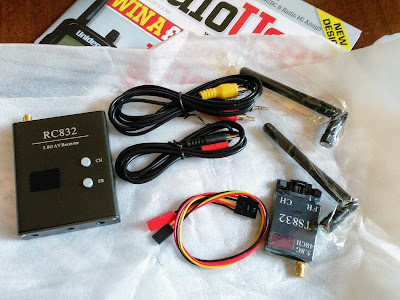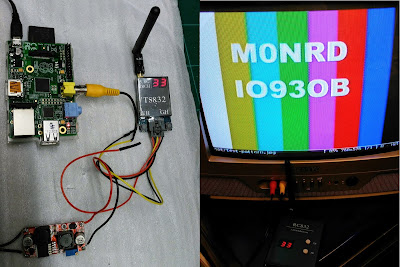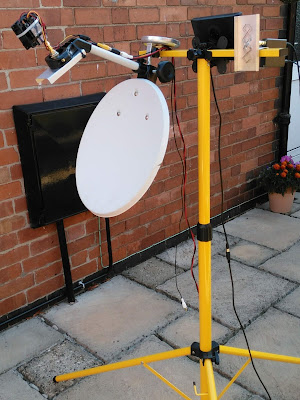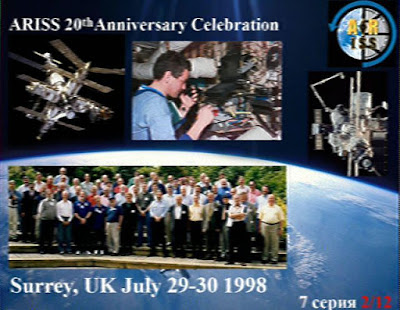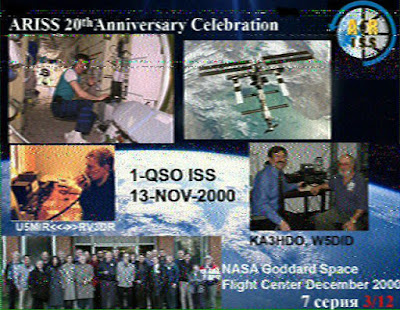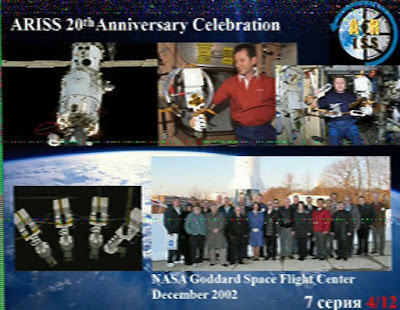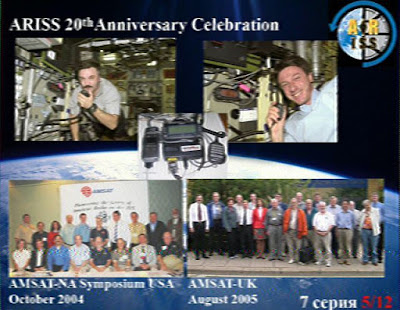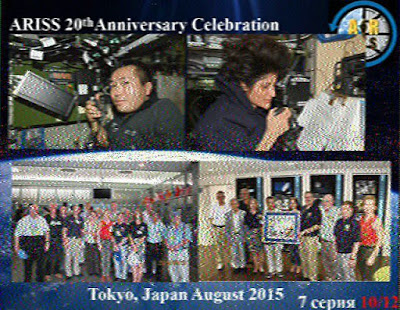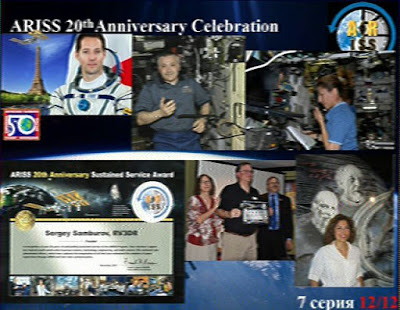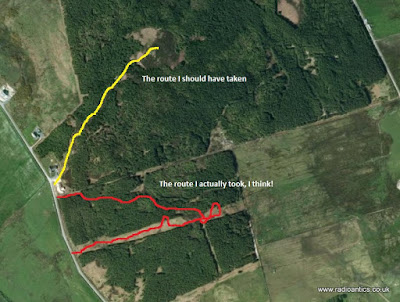Posts Tagged ‘SSTV’
 Moving Pictures! First dabbles in Amateur TV
Moving Pictures! First dabbles in Amateur TV
They say "a picture paints a thousand words"and I've always liked the idea of sending pictures via radio having dabbled with sending and receiving SSTV and SSDV, including pictures from High Altitude Balloons (HABs) like the Hamfest HAB flight I did back in 2015
But I've also been intrigued by "Fast scan TV" to transmit moving images. I've seen demonstrations at conferences and in online videos and joined the British Amateur Television Club BATC a few years ago but apart from reading the CQ-TV magazine I had not done anything mainly due to expense and investment I mistakenly thought I would need to make.
Recently I have seen mention of using easy and low cost equipment to get on the air on 5.6GHz (the 6 cm amateur band) using cheap modules intended to transmit “First Person Video” (FPV) back from drones.
These simple units can be used without any modifications to get on air. A number of operators have used them with high gain WiFi panel and/or dish antennas with a clear line of sight path to send pictures to stations using the same equipment over paths in excess of 50km, the current record is over 160km. Chris Leviston M0KPW has an excellent website describing his 5.6GHz system http://www.5-6ghz-atv.co.uk/ and there is more information at the BATC Wiki https://wiki.batc.org.uk/5.6_GHz
Inspired I ordered some kit from eBay a few weeks back, a receiver module and transmitter arrived quite quickly (no slow boat from China this time)
The equipment is powered by a 12V supply and input and output is a composite video signal and audio. It can be fed by a standard camera or video source but I dug out an old Raspberry Pi and soon had it generating and transmitting a test card with the required call sign overlay. The modules are channelised, the displayed 33 number is bank 3, channel 3 which is 5.665GHz selected by the BATC since it sits inside the amateur allocation,
Over the week I refined the Pi software, adding the Pi camera and various libraries in python to generate video with informational overlay, adding a GPS allowed calculation of the locator square when out portable. I have put it in a box (sorry no picture of that) and a switch to flip between live video and test card. I also had a bash at making some double biquad antennas. Regularly updating my twitter feed with various milestones (I recommend you follow me)
Pi sending live video via 5.6GHz with text overlay using pi camera and raspivid easy peasy.. pic.twitter.com/Fthfpbw0r0— Andrew Garratt M0NRD (@nerdsville) July 28, 2018
While browsing the BATC website for information I spotted that there was an ATV Academy workshop being organised by the Telford and District ARS, giving people the opportunity of finding out a bit more about ATV and people could bring along their equipment and projects for advice. So at the last minute I decided to go but because of the distance could only really go on the Saturday. But it was well worth it and a great day. I was made to feel welcome by everyone there and was able to show off my modest achievements on 5.6GHz and learned about the BATC Portsdown Transceiver and MiniTioune receiver projects, even buying the parts to build the receiver.Lol, wife looking suitably impressed by the Pi based image generator which flips between live feed and test card using switch pic.twitter.com/M6qnif5V0P— Andrew Garratt M0NRD (@nerdsville) August 3, 2018
The academy coincided with a BATC Activity weekend and they were going up to the summit of the nearby Long Mynd to operate on the Sunday. Since I wasn't there I had planned to go to a local high point to see if I could make contact with some of the other operators and stations and got the kit ready on a cheap lighting tripod. I was going to use an old portable satellite dish with one of my double biquads at the feed point.Having a great time learning all about ATV today, showing off my humble efforts pic.twitter.com/YTwEf7Sjdl— Andrew Garratt M0NRD (@nerdsville) August 4, 2018
The satellite dish is inverted because they are offset so when the dish is vertical they are actually pointing around 20 degrees upward towards the TV satellite (in the UK). So for terrestrial use with low elevation they work better inverted. (see here for better description of offset dishes)
I did venture out but I chickened out setting up due to a combination of a surprisingly busy road, fly tipping and very hot conditions. Due to the the fly tipping in the lay-by I didn't want to be seen getting stuff out of car boot! especially as a few cars had slowed down as they passed.
Nevermind I have ordered couple of cheap high-gain mesh dish antennas so when they arrive I will get out again and arrange some skeds, hopefully roping in some of the radio club.
In addition to the 5.6GHz stuff I have also taken possession of an ADALM-PLUTO SDR from Analog Devices. It is inexpensive (£90/$100) and designed to allow educational experimenting in software defined radio. It is a SDR receiver and low-power transmitter. They had been in short supply but availability has improved.
Charles Brain G4GUO has added support for the device into the DATV Express software. I am hoping to use it for some experiments in RB-TV (Reduced bandwidth TV) so I can actually use my NoVs
I took the PLUTO along to the ATV workshop and was able to see it transmitting and being received by other peoples receivers. So last night I got out the two satellite receivers I have and with a little bit of persuasion with settings got some DVB-S DATV transmitted and received.
Anyway, that is enough for now.. but will try to keep the blog updated as I experiment some more, but follow my twitter account @nerdsville for realtime updates 73 AndrewBit of "shaky cam" but shows the ADALM-PLUTO transmitting across the shack using #DATVExpress being received by an old FTA satellite box. pic.twitter.com/souCJA9qBK— Andrew Garratt M0NRD (@nerdsville) August 5, 2018
 ARISS 20th Anniversary SSTV
ARISS 20th Anniversary SSTV
The 20 year history of ARISS was displayed through a collection of 12 images highlighting the accomplishments of the project over the last two decades.
As the ISS has orbited the world it has been transmitting the SSTV signals using FM on the usual downlink of 145.800 MHz, here at my QTH in the UK the passes have occurred late at night into the early morning, averaging 3 - 4 reasonable passes each day.
The signal has been very strong and so some excellent low noise images have been received by many people using just modest equipment. While not the greatest technical achievement in the world it nonetheless generates much needed interest in ARISS and amateur space communication.
My own system consisted of the Yaesu FT-857D and MMSSTV running on the shack PC and was left on automatic receive (I was tucked up in bed) and managed to get decent copies of all the images.
Image 8 reminded me of the fun I had back in 2011-2012 of receiving the ARRISAT-1 and was one of the key things that convinced me to finally get off my backside and actually get licensed, even if it took me another 12 months and to this day haven't really cracked satellites myself! My previous blog posts on that can be found at http://nerdsville.blogspot.co.uk/search/label/arissat-1
Here are the best of my images, for a full description of what each one depicts visit http://ariss-sstv.blogspot.co.uk/2017/07/anniversary-image-descriptions.html
 ARISS 20th Anniversary SSTV
ARISS 20th Anniversary SSTV
The 20 year history of ARISS was displayed through a collection of 12 images highlighting the accomplishments of the project over the last two decades.
As the ISS has orbited the world it has been transmitting the SSTV signals using FM on the usual downlink of 145.800 MHz, here at my QTH in the UK the passes have occurred late at night into the early morning, averaging 3 - 4 reasonable passes each day.
The signal has been very strong and so some excellent low noise images have been received by many people using just modest equipment. While not the greatest technical achievement in the world it nonetheless generates much needed interest in ARISS and amateur space communication.
My own system consisted of the Yaesu FT-857D and MMSSTV running on the shack PC and was left on automatic receive (I was tucked up in bed) and managed to get decent copies of all the images.
Image 8 reminded me of the fun I had back in 2011-2012 of receiving the ARRISAT-1 and was one of the key things that convinced me to finally get off my backside and actually get licensed, even if it took me another 12 months and to this day haven't really cracked satellites myself! My previous blog posts on that can be found at http://nerdsville.blogspot.co.uk/search/label/arissat-1
Here are the best of my images, for a full description of what each one depicts visit http://ariss-sstv.blogspot.co.uk/2017/07/anniversary-image-descriptions.html
 LHS Episode #161: Someone Spelt the Soup
LHS Episode #161: Someone Spelt the Soup
 This is a very exciting episode of Linux in the Ham Shack for us. It's so special, that it's a double episode! That's right, it's like getting two episodes in one. Your hosts (one of them new to the program) discuss winter field day, WxBot, the origin of Debian Linux, SSTV using Linux, OpenSSH security concerns, solving the Rubik's Cube with Linux and a whole lot more. Hope you enjoy, and please welcome our new host!
This is a very exciting episode of Linux in the Ham Shack for us. It's so special, that it's a double episode! That's right, it's like getting two episodes in one. Your hosts (one of them new to the program) discuss winter field day, WxBot, the origin of Debian Linux, SSTV using Linux, OpenSSH security concerns, solving the Rubik's Cube with Linux and a whole lot more. Hope you enjoy, and please welcome our new host!
73 de The LHS Crew
 Radio antics on the Inner Hebrides
Radio antics on the Inner Hebrides
It was our fourth visit to Skye but Islay was a new destination for us. While it was primarily a holiday away with the wife and dogs doing some walking, sight-seeing, visiting the numerous malt whisky distilleries (especially on Islay and Jura) I also planned to do some operating.
Last year I did operate from the same rented cottage on Skye but this year I wanted to do some portable working on both islands. With this in mind and following my disappointment last month I had taken time to properly prepare. As well as repairing the end-fed wire "magitenna" that had caused issues last time out I had constructed a linked dipole for 40m/20m for a simple inverted-vee using a fibreglass windsock pole.
I took the Yaesu FT857-D with a small SLA battery for portable work and a small power supply when in the cottages. Unfortunately things didn't get off to a good start when I dropped the battery when unpacking. I had used a small screw-terminal chock block to connect to the power loom and the weight of the battery simply ripped both wires out of the terminal block and they touched with an almighty spark and welded themselves together. I acted quickly to remove them from the battery but it has almost certainly affected the battery. Despite this set back the battery performance proved more than sufficient for my needs.
During the first week on Skye, the South Kesteven ARS, which I am the chairman, had their monthly meeting and we planned to try and make a scheduled contact (sked) I did have a run through one evening to test the set up and antenna, drinking a beer and making contacts while sitting on a bench at the cottage watching the sunset going down over Loch Bay with the Outer Hebrides in the distance - sheer bliss!
On the night of the sked the famous Scottish midges were out in abundance and I opted to work from inside the cottage. A successful contact and conversation was made even if there were a few issues at the club that night. They were unable to get the planned antenna up due to activities in the nearby scout hut but like all good hams they improvised using an Ampro-40 magmounted vertical on top of a large saucepan until they were able to get a dipole up but by then band conditions had started deteriorating, but a contact is a contact.
Going portable I had planned to do some Worked All Britain Award activations, the W.A.B scheme uses the Ordnance Survey (OS) mapping agencies National Grid Reference (NGR) system to divide the country into 10km x 10km grid squares. The aim is for activators to operate from the squares and for other operators to “work” those squares.
In addition to activating squares, operators can also activate pillar type triangulation points (commonly known as 'Trig Points') which were originally used to carry out the surveying for Ordnance Survey maps but have now been abandoned and have become interesting relics and many are now sadly falling into disrepair, however many people still seek them out and a database exists at www.trigpointing.uk
I planned to try to activate some squares and trig points as the more remote locations such as the Scottish Islands are highly sort after as they don’t get activated as often.
Firstly before I describe my adventures let me be brutally honest! I am fat, in fact very fat and unfit!
I haven’t always in such poor shape, in fact I used to be a keen walker regularly going out at weekends walking miles and even completed several long distance footpaths, including The Coast to Coast Walk back in 1991. I then spent many years competing in dog agility most weekends which kept me reasonably fit but the last few years circumstances have changed and I now have a sedentary lifestyle and desk bound job. This coupled with stress, apathy and being a more than willing victim of comfort eating mean I have piled on the pounds.
Why make this confession? Simply because most trig points are on prominent hill tops and high ground throughout the country and therefore will require some physical climbing to get to them. I was under no illusion there were many on Skye and Islay that I stood no chance of reaching without some form of coronary episode! But I had identified a number of more attainable ones requiring on paper just a modest exertion.
How wrong I was..
On the Isle of Skye we were staying on the Waternish peninsular and I had identified two possible candidates the nearby Ben Horneval (TP1275) and Ben Geary (TP1269) while both were over 260 meters in height the maps and descriptions seemed to indicate reasonable but still strenuous approaches. However prior to us arriving the weather had been very wet and the ground was very boggy and when actually standing looking up at the hills I sensibly thought "Not a chance!"
Instead I opted to go to the coast, specifically Talisker Bay which is glorious and simply activate a WAB square NG33 while the wife and dogs occupied themselves on the beach. So off we went, drove across Skye and walked the mile or so from the parking area carrying the rucksack with radio and pole. I went of to a nice spot just up of the beach to set up to then discover I had forgotten to pack the coax... never mind had a good few hours on the beach and stopped off at the Talisker distillery on the way back.
There were a number of suggested approaches, on the first we were met with fences, livestock and a sign saying private and seeing no obvious path up we investigated another through a gate on the main road. This was more straightforward however the nearest parking area was a little way down from the gate. The road was extremely busy and we weren’t comfortable trying to walk up the road with the dogs due to the traffic. I was feeling at little peeved at this point and opted to stay with the car while the wife retrieved the cache and took a photo so I know what I missed.
In the end I made no trig point activations on the Isle of Skye, but should we go back at least I am more prepared.
The second week of our holiday was on Islay. Islay is simply a fantastic place to visit, much quieter than Skye, probably due to the two hour ferry journey involved and I did manage some portable operating between visiting the eight whisky distilleries and a trip to a ninth on nearby Jura.
The cottage we were staying in overlooked Lagavulin Bay with the Lagavulin Distillery and the remains of Dunyvaig Castle, it was a two minute walk to a high point near the ruins where I set up one evening and had an hour operating in the setting sun, again band conditions were poor but I didn't care, NR44 was activated.
There were two trig-points quite near to the cottage. Ardmore Point (TP0875), from the map this looked simple enough, however the road to Ardmore was a private road so couldn’t take the car and while walking there from the nearest parking space was simple enough time didn’t allow it.
Cnoc Rhaonastil (TP2293) was another potential trig point, locally called the Fairy Hill it promised spectacular views for short but steep walk, however again parking and access proved problematic and so was never attempted.
The Mull of Oa (TP4976) trig-point I actually walked to being next to the American Monument which commemorates the loss of two troop ships in 1918, the Tuscania and the Otranto and the spectacular location overlooks the very spot where the Tuscania sunk. The monument built to thank the inhabitants of Islay for their help is built in the shape of a lighthouse and is visible from many areas on Islay. Despite the very wet ground conditions the walk was straightforward however the weather put paid to any attempt at activating. The wind was very very strong, as this short video demonstrates.
The attempt on An Curran (TP0839) really was a comedy of errors, being a fairly modest 49m high and close to where we were staying it should have been straightforward. To get to the summit you have to navigate a dense conifer forest and I had read the description on the trigpointing.uk website of how to ascend via a gate and distinct path.
It looked short and simple so didn't take a map or the GPS with me. I found a gate and what seemed like a path along a wall and set off and quickly the path became indistinct and the trees were indeed very dense, so dense I was struggling to get through them. But I carried on going up gaining altitude thinking I must be nearing the top, however it got to the point I just couldn’t get through the trees anymore and there was no sign of them thinning out as they supposedly did at the summit. It started raining and was having to negotiate water filled hollows, heather and bracken hummocks and swarms of midges - this was not fun!
Eventually I did spot a clearing only to find it was where a power line ran up the hillside. I knew I was too far south and since going north through the forest was neigh on impossible I instead descended following the power line through chest high bracken back to the road, all the time worrying about "Serpents" as the locals quaintly called the adders which were prevalent this year. When I did reach the road I had to climb a low dry stone wall and promptly slipped into a deep water filled ditch on the other side, losing a boot in the peaty mud much to the amusement of a passing group of horse riders.
I almost decided that this was enough, I was doomed not to activate a trig point however one remained on the hit list and I succeeded in activating it on the final day.
I had spotted Cnoc Lolairean (TP2283) when visiting the nearby Bruichladdich Distillery earlier in the week, only 29 meters high it was on a small ridge along the side of Loch Indaal and it involved just a short walk up a farm track and up a narrow track to the top.
The wife went of to get a coffee from the nearby mini-market and took the dogs for a walk on the nearby beach while I went to the trig point. What it lacked in height it made up for with the position with fantastic view across to Bowmore and down the Loch.
I used bungee cords to hold the pole to the pillar and soon had the inverted-vee up on 40m. I had around 40 minutes of operating, and band conditions were again poor with lots of noise but I did make a decent number of contacts running approximately 20W before the battery voltage started to drop off. I was especially pleased to work Stewart M0SDM a fellow SKARS member.
 Radio antics on the Inner Hebrides
Radio antics on the Inner Hebrides
It was our fourth visit to Skye but Islay was a new destination for us. While it was primarily a holiday away with the wife and dogs doing some walking, sight-seeing, visiting the numerous malt whisky distilleries (especially on Islay and Jura) I also planned to do some operating.
Last year I did operate from the same rented cottage on Skye but this year I wanted to do some portable working on both islands. With this in mind and following my disappointment last month I had taken time to properly prepare. As well as repairing the end-fed wire "magitenna" that had caused issues last time out I had constructed a linked dipole for 40m/20m for a simple inverted-vee using a fibreglass windsock pole.
I took the Yaesu FT857-D with a small SLA battery for portable work and a small power supply when in the cottages. Unfortunately things didn't get off to a good start when I dropped the battery when unpacking. I had used a small screw-terminal chock block to connect to the power loom and the weight of the battery simply ripped both wires out of the terminal block and they touched with an almighty spark and welded themselves together. I acted quickly to remove them from the battery but it has almost certainly affected the battery. Despite this set back the battery performance proved more than sufficient for my needs.
During the first week on Skye, the South Kesteven ARS, which I am the chairman, had their monthly meeting and we planned to try and make a scheduled contact (sked) I did have a run through one evening to test the set up and antenna, drinking a beer and making contacts while sitting on a bench at the cottage watching the sunset going down over Loch Bay with the Outer Hebrides in the distance - sheer bliss!
On the night of the sked the famous Scottish midges were out in abundance and I opted to work from inside the cottage. A successful contact and conversation was made even if there were a few issues at the club that night. They were unable to get the planned antenna up due to activities in the nearby scout hut but like all good hams they improvised using an Ampro-40 magmounted vertical on top of a large saucepan until they were able to get a dipole up but by then band conditions had started deteriorating, but a contact is a contact.
Going portable I had planned to do some Worked All Britain Award activations, the W.A.B scheme uses the Ordnance Survey (OS) mapping agencies National Grid Reference (NGR) system to divide the country into 10km x 10km grid squares. The aim is for activators to operate from the squares and for other operators to “work” those squares.
In addition to activating squares, operators can also activate pillar type triangulation points (commonly known as 'Trig Points') which were originally used to carry out the surveying for Ordnance Survey maps but have now been abandoned and have become interesting relics and many are now sadly falling into disrepair, however many people still seek them out and a database exists at www.trigpointing.uk
I planned to try to activate some squares and trig points as the more remote locations such as the Scottish Islands are highly sort after as they don’t get activated as often.
Firstly before I describe my adventures let me be brutally honest! I am fat, in fact very fat and unfit!
I haven’t always in such poor shape, in fact I used to be a keen walker regularly going out at weekends walking miles and even completed several long distance footpaths, including The Coast to Coast Walk back in 1991. I then spent many years competing in dog agility most weekends which kept me reasonably fit but the last few years circumstances have changed and I now have a sedentary lifestyle and desk bound job. This coupled with stress, apathy and being a more than willing victim of comfort eating mean I have piled on the pounds.
Why make this confession? Simply because most trig points are on prominent hill tops and high ground throughout the country and therefore will require some physical climbing to get to them. I was under no illusion there were many on Skye and Islay that I stood no chance of reaching without some form of coronary episode! But I had identified a number of more attainable ones requiring on paper just a modest exertion.
How wrong I was..
On the Isle of Skye we were staying on the Waternish peninsular and I had identified two possible candidates the nearby Ben Horneval (TP1275) and Ben Geary (TP1269) while both were over 260 meters in height the maps and descriptions seemed to indicate reasonable but still strenuous approaches. However prior to us arriving the weather had been very wet and the ground was very boggy and when actually standing looking up at the hills I sensibly thought "Not a chance!"
Instead I opted to go to the coast, specifically Talisker Bay which is glorious and simply activate a WAB square NG33 while the wife and dogs occupied themselves on the beach. So off we went, drove across Skye and walked the mile or so from the parking area carrying the rucksack with radio and pole. I went of to a nice spot just up of the beach to set up to then discover I had forgotten to pack the coax... never mind had a good few hours on the beach and stopped off at the Talisker distillery on the way back.
There were a number of suggested approaches, on the first we were met with fences, livestock and a sign saying private and seeing no obvious path up we investigated another through a gate on the main road. This was more straightforward however the nearest parking area was a little way down from the gate. The road was extremely busy and we weren’t comfortable trying to walk up the road with the dogs due to the traffic. I was feeling at little peeved at this point and opted to stay with the car while the wife retrieved the cache and took a photo so I know what I missed.
In the end I made no trig point activations on the Isle of Skye, but should we go back at least I am more prepared.
The second week of our holiday was on Islay. Islay is simply a fantastic place to visit, much quieter than Skye, probably due to the two hour ferry journey involved and I did manage some portable operating between visiting the eight whisky distilleries and a trip to a ninth on nearby Jura.
The cottage we were staying in overlooked Lagavulin Bay with the Lagavulin Distillery and the remains of Dunyvaig Castle, it was a two minute walk to a high point near the ruins where I set up one evening and had an hour operating in the setting sun, again band conditions were poor but I didn't care, NR44 was activated.
There were two trig-points quite near to the cottage. Ardmore Point (TP0875), from the map this looked simple enough, however the road to Ardmore was a private road so couldn’t take the car and while walking there from the nearest parking space was simple enough time didn’t allow it.
Cnoc Rhaonastil (TP2293) was another potential trig point, locally called the Fairy Hill it promised spectacular views for short but steep walk, however again parking and access proved problematic and so was never attempted.
The Mull of Oa (TP4976) trig-point I actually walked to being next to the American Monument which commemorates the loss of two troop ships in 1918, the Tuscania and the Otranto and the spectacular location overlooks the very spot where the Tuscania sunk. The monument built to thank the inhabitants of Islay for their help is built in the shape of a lighthouse and is visible from many areas on Islay. Despite the very wet ground conditions the walk was straightforward however the weather put paid to any attempt at activating. The wind was very very strong, as this short video demonstrates.
The attempt on An Curran (TP0839) really was a comedy of errors, being a fairly modest 49m high and close to where we were staying it should have been straightforward. To get to the summit you have to navigate a dense conifer forest and I had read the description on the trigpointing.uk website of how to ascend via a gate and distinct path.
It looked short and simple so didn't take a map or the GPS with me. I found a gate and what seemed like a path along a wall and set off and quickly the path became indistinct and the trees were indeed very dense, so dense I was struggling to get through them. But I carried on going up gaining altitude thinking I must be nearing the top, however it got to the point I just couldn’t get through the trees anymore and there was no sign of them thinning out as they supposedly did at the summit. It started raining and was having to negotiate water filled hollows, heather and bracken hummocks and swarms of midges - this was not fun!
Eventually I did spot a clearing only to find it was where a power line ran up the hillside. I knew I was too far south and since going north through the forest was neigh on impossible I instead descended following the power line through chest high bracken back to the road, all the time worrying about "Serpents" as the locals quaintly called the adders which were prevalent this year. When I did reach the road I had to climb a low dry stone wall and promptly slipped into a deep water filled ditch on the other side, losing a boot in the peaty mud much to the amusement of a passing group of horse riders.
I almost decided that this was enough, I was doomed not to activate a trig point however one remained on the hit list and I succeeded in activating it on the final day.
I had spotted Cnoc Lolairean (TP2283) when visiting the nearby Bruichladdich Distillery earlier in the week, only 29 meters high it was on a small ridge along the side of Loch Indaal and it involved just a short walk up a farm track and up a narrow track to the top.
The wife went of to get a coffee from the nearby mini-market and took the dogs for a walk on the nearby beach while I went to the trig point. What it lacked in height it made up for with the position with fantastic view across to Bowmore and down the Loch.
I used bungee cords to hold the pole to the pillar and soon had the inverted-vee up on 40m. I had around 40 minutes of operating, and band conditions were again poor with lots of noise but I did make a decent number of contacts running approximately 20W before the battery voltage started to drop off. I was especially pleased to work Stewart M0SDM a fellow SKARS member.
 April Radio Antics
April Radio Antics
During the Easter holiday I was away in the caravan at a dog agility show in North Yorkshire, camping in the grounds of Duncombe Park just outside Helmsley. When not competing I was able to find some time to operate.
 |
| Boris combining both hobbies! |
Using just an M0CVO Magitenna I had some reasonable low power SSB operation on a number of bands and activated a square for the Worked All Britain Award (WAB) (SE58) and gave some points away during the Polish SP DX Contest.
The WAB scheme was something I signed up for last year when I went to Skye but haven't participated till now. The WAB net on 7.160MHz is a little daunting to listen too but once I jumped in it was relatively painless to activate the square and I plan to do some more when I go back to the Isle of Skye and Islay later this year, but I must improve my portable HF antenna.
Over the weekend of the 11/12th April there was another SSTV activation from the ISS in celebration of Yuri Gargarin's life. I had some good results decoding images and decided that I'd use it as a way to promote South Kesteven ARS locally and contacted the local newspaper.
The Newark Advertiser did indeed feature the story both in print and on their website and they were very good in mentioning the radio society. It was also printed in the sister free paper.
 |
| Copyright Newark Advertiser |
It was nice to get some very complimentary reaction to my publicity drive in social media and other websites including an article on the Amsat-UK page http://amsat-uk.org/2015/04/15/iss-sstv-in-the-press/
Situated on the Lincolnshire/Leicestershire border ROC Post Number 62 is leased to the UP AN’ AT EM! History project and has been restored as a museum and is managed by Jed Jaggard. The free open day was a rare chance to visit and experience an important part of British post-war history.
These bunkers are underground structures found all over the United Kingdom, constructed as a result of the Corps’ civil defence nuclear reporting role and were operated by volunteers during the Cold War between 1955 and 1991. There was a network of over 1500 such monitoring posts around the UK designed to detect nuclear detonations and monitor blast and subsequent fallout and radiation levels should an attack take place.
Thankfully they were never used and the last of the posts were closed in 1991 when the majority of the ROC was stood down following the break-up of the Communist Bloc. Many have been demolished, fill in or adapted to other uses but the majority still exist, although in a derelict condition.
During the open day visitors had the chance to climb down into the bunker so for reasons of practicality SKARS operated GB5ROC from a tent close to the bunker hatch.
Along with Stewart Mason (M0SDM) and Sean Burton (2E0ENN) we operated on 40m from 10:00 till 16:30 BST and made a total of 151 contacts mostly UK operators with a number of European stations.
Equipment was supplied by Stewart who did the majority of the operating and consisted of a Yaesu FT-897D at 100W feeding an off centre fed dipole at around 30ft on top of a Racal push up mast. Stewart also provided a new club banner.
The open day was very well attended and a number of local and not so local amateurs (one visitor from Australia VK4UA ) came along thanks to the publicity the event had received on Facebook, Twitter, GB2RS and the Southgate ARC newsfeed. It was great to meet up and chat.
Encouragingly members of the general public were keen to learn what amateur radio was all about and they were able to take away a number of leaflets with information about the hobby and contact details for SKARS.
It was an excellent day all round with the operators have a fun time and gaining useful experience of operating a pile-up. The weather was kind with blue skies and sunshine. Hopefully it will become a regular activation at future bunker activations.
The video below Stewart operating Richard M6GPT who had tried most of the day to make contact and was successful just before the station was closed down.
SKARS member Mark (M0OBL) had monitored GB5ROC and made a video of his Elecraft K2 receiving us load and clear.
Next month is going to be very busy as I have GB2EGG and the Eggsplorer-1 HAB flight to organise and that too has made the press. http://www.sleafordtarget.co.uk/Egg-sent-space-World-Egg-Throwing-Championships/story-26372439-detail/story.html
Oh and lastly remember this is the original "Radio Antics" blog, often imitated but never bettered.. 73
Update, the visit of VK4UA to GB5ROC wasn't due to any publicity or advertising - it was simply because Stewart had his van parked on the verge with his callsign clearly visible and he was visiting the area - the simplest ideas are the best it seems!

